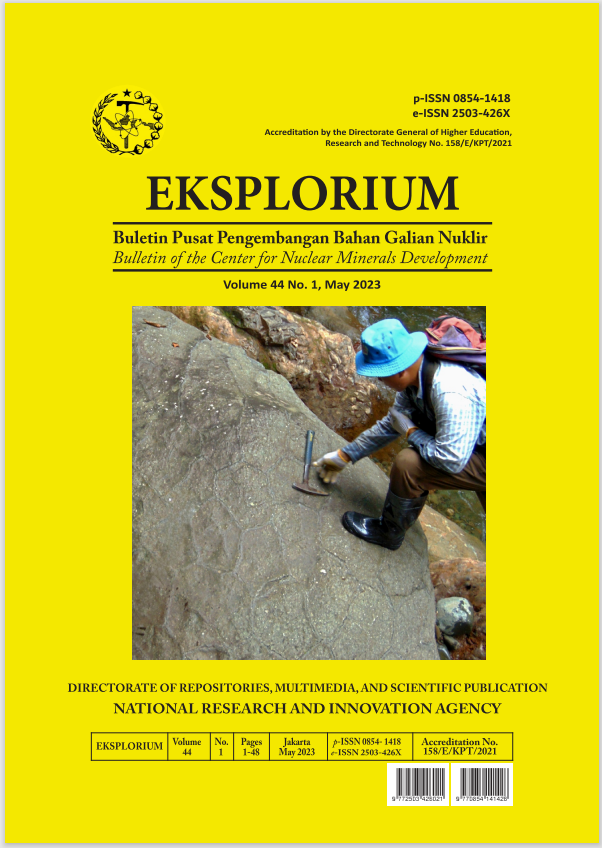The Effect of Fly Ash Ratio Addition as Layering Material Using Free Draining Column Leach Test Method on Laboratory Scale
Main Article Content
Abstract
Acid mine drainage (AMD) is formed due to the oxidation of sulfide minerals in the presence of water and air. AMD already entering the environment can damage the aquatic ecosystem due to low pH and high dissolved metal concentrations. Efforts to prevent the formation of AMD are by regulating the stockpiling of materials containing sulfide or potential acid forming (PAF) with non-acid forming (NAF) to avoid oxidation reactions of sulfide minerals. The purpose of this study was to simulate the effect of adding fly ash ratio as a PAF rock coating material to the quality characteristics of leachate using the laboratory-scale free draining column leach test (FDCLT) method. Adding fly ash ratio as a layering material significantly affects the quality of the resulting leachate. This is due to the physical condition of the fly ash material, which cannot prevent the meeting of AMD-forming components.
Article Details

This work is licensed under a Creative Commons Attribution-ShareAlike 4.0 International License.
1. Introduction
By using or sharing content from EKSPLORIUM - Buletin Pusat Pengembangan Bahan Galian Nuklir ("the Journal"), you agree to follow these Terms and Conditions. The Journal's content is licensed under the Creative Commons Attribution-NonCommercial-ShareAlike (CC BY-NC-SA) license. If you do not agree to these terms, please do not use the content.
2. How You Can Use the Content
-
Share: You can copy, share, and distribute the work, but only for non-commercial purposes.
-
Adapt: You can change, remix, or build on the work, as long as it is for non-commercial purposes and you share it under the same license (CC BY-NC-SA).
3. Attribution (Giving Credit)
When you use or share the content, you must:
-
Give proper credit to the author(s).
-
Mention the title of the work and the journal name.
-
Provide a link to the license (https://creativecommons.org/licenses/by-nc-sa/4.0/).
-
Indicate if you made any changes to the work.
4. Non-Commercial Use
You cannot use the work to make money or for any commercial activities. For example, you cannot sell or use the content in advertisements.
If you want to use the content for commercial purposes, you need to get permission from the author(s) or the publisher.
5. ShareAlike
If you make changes to the content (like creating a new version or remixing it), you must share your new version under the same CC BY-NC-SA license.
6. Exclusions
Some materials in the Journal may have different licenses or restrictions, such as third-party content (like images or datasets). You must respect the rules for those materials.
7. No Warranty
The content is provided "as is." The authors and publisher do not guarantee that the content is error-free or suitable for any specific purpose. Use the content at your own risk.
8. Modifications and Withdrawal of Content
The publisher and authors can update or remove content at any time. If content is removed, the previous versions will still follow these terms.
9. Ethical Use
You must use the content ethically and follow all relevant laws. This includes properly citing the original authors and not misusing the content.
10. Legal Compliance
You are responsible for making sure your use of the content follows the laws of your country. If you believe content violates your rights, please contact us.
11. Changes to Terms
These Terms and Conditions may be updated from time to time. Any changes will be posted on the Journal's website.
12. Contact Information
For questions about these Terms or for permission to use content commercially, please contact us at:
-
Email: eksplorium@brin.go.id
-
Website: https://ejournal.brin.go.id/eksplorium
Conclusion
By using the content from EKSPLORIUM - Buletin Pusat Pengembangan Bahan Galian Nuklir, you agree to follow these Terms and Conditions and the CC BY-NC-SA 4.0 International License.
References
T. S. Win, S. Dwiki, A. Hamanaka, T. Sasaoka, H. Shimada, S. Matsumoto, and G. J. Kusuma, “Application of Fly Ash and Organic Material as Dry Cover System in Prevention of Acid Mine Drainage Generation,” Journal of Geoscience and Environment Protection, vol. 8, pp. 56-64, 2020. https://doi.org/10.4236/gep.2020.85004.
R. S. Gautama, Pembentukan, Pengendalian dan Pengelolaan Air Asam Tambang. Bandung, Indonesia: Penerbit ITB, 2014.
B. G. Lottermoser, Mine Wastes: Characterization, Treatment and Environmental Impacts. Springer, 2010. https://doi.org/10.1007/ 978-3-642-12419-8.
G. J. Kusuma, H. Shimada, T. Sasaoka, K. Matsui, C. Nugraha, R. S. Gautama, and B. Sulistianto, “An Evaluation on the Physical and Chemical Composition of Coal Combustion Ash and Its Co-Placement with Coal-Mine Waste Rock,” Journal of Environmental Protection, vol. 3, pp. 589-596, 2012. https://doi.org/10.4236/ jep.2012.37071.
R. Damayanti, “Abu Batubara dan Pemanfaatanya: Tinjauan Teknik Karakteristik Secara Kimia dan Toksikologinya,” Teknologi Mineral dan Batubara Journal, vol. 14, no. 3, pp. 213-231, 2018.
M. S. Said, S. R. Nurhawaisyah, M. I. Juradi, N. Asmiani, G. J. Kusuma, “Analisis Kandungan Fly Ash sebagai Alternatif Bahan Penetraldalam Penanggulangan Air Asam Tambang,” Jurnal Geomine Journal, vol. 7, no. 3, pp. 163-170, 2019.
M. A. Syaefudin, A. Triantoro, Riswan, “Analisis Pemanfaatan Fly Ash dan Bottom Ash sebagai Material Alternatif NAF yang digunakan dalam Upaya Pencegahan Pembentukan Air Asam Tambang, ”GEOSAPTA Journal, vol. 6 no.1, pp. 39-42, 2020.
G. J. Kusuma, Study on the Acid Mine Drainage Generation at Coal Mine Overburden Dumps in Indonesia and Its Control System, Using Ash Fly. Japan: Kyushu University, 2012.
AMIRA, ARD test handbook, AMIRA P387A Project: Prediction and Kinetic Control of Acid Mine Drainage, Melbourne, VIC: AMIRA International, 2002.

